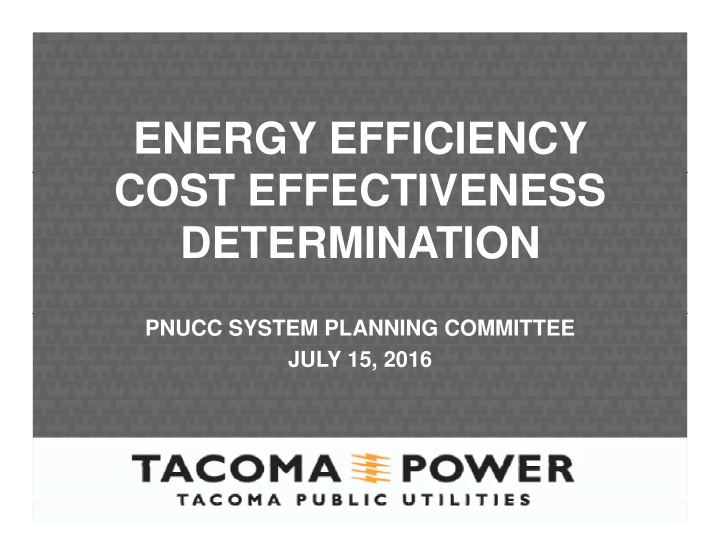



ENERGY EFFICIENCY COST EFFECTIVENESS DETERMINATION DETERMINATION PNUCC SYSTEM PLANNING COMMITTEE JULY 15, 2016
TACOMA POWER • Municipal owned utility formed in 1893 • Tacoma is Washington state’s third largest city • Power supplied from clean, low ‐ cost, hydropower since 1912 • Energy efficiency (EE) is Tacoma’s new energy resource choice • Defers the need to acquire costly new supply • Defers the need to acquire costly new supply resources • EE provides direct benefits to customers, helps support the EE provides direct benefits to customers, helps support the local economy, and is an environmentally friendly resource • Acquired 57 aMW of EE since 2007 2
A HISTORY OF EE ACQUISITION SUCCESS
COST EFFECTIVENESS REQUIREMENT RCW 80.52.030(7) “Cost ‐ effective” means that a project or resource is forecast: (a) To be reliable and available within the time it is needed; and (b) To meet or reduce the electric power demand of needed; and (b) To meet or reduce the electric power demand of the intended consumers at an estimated incremental system cost no greater than that of the least ‐ cost similarly reliable and available project or resource or any combination thereof project or resource, or any combination thereof. The Energy Independence Act Each qualifying utility shall pursue all available conservation that is • cost ‐ effective, reliable, and feasible. requires qualifying utilities determine their conservation potential requires qualifying utilities determine their conservation potential • • using “methodologies consistent with the Pacific Northwest Electric Power and conservation planning council” (19.285.040(1)(a) RCW) 4
SUMMARY OF 2015 IRP 2016 ‐ 2035 CPA Avoided cost based on the wholesale • market price forecast Included avoided cost adders for: • 10% preference for conservation (Energy only) 10% preference for conservation (Energy only) • • Gas risk adder ($2.42 ‐ $5.27/MWh) • T&D capital improvement deferral ($1.74 / MWh) p p ( ) • Avoided REC purchases for I ‐ 937 compliance ($0.54 ‐ $1.26/MWh) • Carbon emission premium(assumptions included in wholesale price) • Achievable economic potential: 10 yr = 46.8 aMW, 20 yr = 78.7 aMW 5
SUMMARY OF 2015 IRP Components of Avoided Cost 70.00 60.00 6 Real) 50.00 /MWh (2016 40.00 40 00 30.00 20 00 20.00 $ 10.00 0.00 2016 2017 2018 2019 2020 2021 2022 2023 2024 2025 2026 2027 2028 2029 2030 2031 2032 2033 2034 2035 2016 Wholesale CPA Gas Risk Adder Avoided REC purchase T&D Benefit Adder 10% for Conservation T&D Benefit Adder 10% for Conservation 6
WHAT COULD CHANGE IN THE 2017 IRP? • Retail load forecast and estimates of Load Resource Balance • What is the applicable avoided cost? What is the applicable avoided cost? • Avoided cost adders Value of capacity • Another look at carbon emission policy • Expanding the application of the 10% conservation preference to capacity • and T&D benefits Re ‐ examine T&D benefits using engineering data • • Updates to the discount rate(2.7% to 3.0%) and inflation rate (1% to 2%) 7
WHAT COULD CHANGE IN THE 2017 IRP? Tacoma Power Load: Forecasts v. Actual 660 640 620 W) lity Load (aMW 600 580 560 560 Util 540 2007 2005 2009 2011 2013 2015 2016 520 520 500 8
ALTERNATIVE AVOIDED COSTS 70.00 60.00 50.00 016 Real) 40.00 $/MWh (20 30.00 20.00 BPA Block Rate Assumes: +3%/year BPA Block Rate Assumes: +3%/year 10.00 0.00 2016 2017 2018 2019 2020 2021 2022 2023 2024 2025 2026 2027 2028 2029 2030 2031 2032 2033 2034 2035 2036 2015 Price Forecast BPA Block Rate (estimate) 2016 Draft Price Forecast 2016 Draft Price Forecast Resource Cost Resource Cost 9
LRB AND AVOIDED COST SURPLUS EE savings reduces BPA contract net requirement Avoided Cost = BPA Rate DEFICIT DEFICIT EE savings reduces need for new power supply Avoided Cost = Market Price VERY DEFICIT Expectation of new large single load Expectation of new large single load Avoided Cost = lowest cost, reliable, feasible resource or PPA 10
QUESTIONS? THANK YOU! 11
Recommend
More recommend